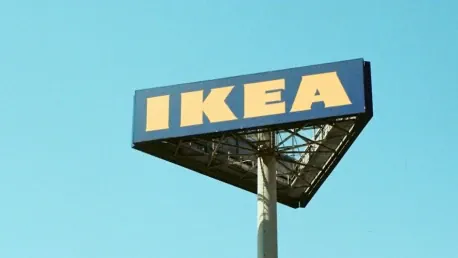Ikea has embarked on an innovative venture to expand its sustainability mission by introducing an online secondhand marketplace, dubbed Ikea Preowned. This trial is being conducted exclusively in Oslo and Madrid with ambitions of tapping into the growing secondhand furniture market while simultaneously competing with established platforms like eBay. By focusing on affordability, sustainability, and leveraging technology to streamline the user experience, Ikea aims to offer a compelling option for customers looking to buy or sell used Ikea furniture effortlessly.
Sustainability and Affordability: Making Preloved Furniture Accessible
Ikea’s Commitment to Sustainability
One of the driving forces behind Ikea Preowned is the company’s commitment to sustainability. By promoting the reuse of furniture, Ikea addresses critical environmental concerns related to waste and resource utilization. Chief Executive Jesper Brodin has emphasized the importance of enabling consumers to own quality Ikea products at lower prices, all while supporting environmental sustainability. This dual focus reflects a broader shift within retail toward circular economy principles, which prioritize recycling, reusing, and reducing waste.
Ikea Preowned’s approach to sustainability involves a pragmatic strategy of extending the lifecycle of furniture, thereby reducing the environmental impact associated with manufacturing new products. This initiative aligns with global efforts to decrease carbon footprints and conserve natural resources, showing that Ikea is not just selling products but also contributing to a greener planet. By providing a platform dedicated to the resale of Ikea furniture, the company encourages consumers to participate in a more sustainable form of consumption.
Affordability for Budget-conscious Consumers
Ikea Preowned also caters directly to budget-conscious consumers by offering more affordable options for acquiring quality furniture. The platform allows users to buy and sell preloved Ikea items easily, making it possible for customers to furnish their homes stylishly without breaking the bank. This initiative not only broadens the accessibility of Ikea products but also encourages more sustainable consumer behavior by extending the lifecycle of furniture.
The marketplace’s focus on affordability is particularly significant in today’s economic climate, where many consumers are looking for ways to reduce expenses without compromising on quality. By providing a wide range of budget-friendly options, Ikea Preowned ensures that high-quality, stylish furniture is within reach for a broader audience. Furthermore, this platform fosters a culture of reuse and value preservation, reinforcing the idea that purchasing secondhand items can be both economical and environmentally responsible.
Leveraging Technology for an Enhanced User Experience
AI Integration for Seamless Selling
A significant highlight of the Ikea Preowned platform is its incorporation of artificial intelligence (AI) to simplify and enhance the selling process. Customers can upload images and set prices for their used Ikea items with ease. The platform’s AI system then automatically generates supplementary promotional images and measurements, streamlining what can often be a cumbersome task. This smart integration of technology aims to create a user-friendly experience, encouraging more participation in the secondhand market.
AI’s role in Ikea Preowned does not stop at merely generating images and measurements; it also helps in optimizing listings for better visibility and relevance. By analyzing user preferences and behaviors, the AI system can recommend pricing strategies and highlight popular items, thereby increasing the chances of successful transactions. This intelligent use of technology ensures that sellers can reach potential buyers more effectively, making the marketplace dynamic and highly interactive for all participants.
User-centric Features and Tools
Further advancing the platform’s appeal, Ikea Preowned includes various user-centric features designed to make buying and selling preloved furniture as hassle-free as possible. These tools provide detailed product information, condition reports, and transparent pricing, ensuring that both buyers and sellers have a clear understanding of the items being exchanged. By focusing on enhancing user experience, Ikea hopes to build a reliable and attractive marketplace for conscious consumers.
These user-centric features also include advanced search filters, personalized recommendations, and secure payment options, making the transaction process smooth and trustworthy. By offering comprehensive details and ensuring transparency, Ikea Preowned aims to mitigate the common concerns associated with secondhand purchases, such as quality and authenticity. This focus on trust and convenience not only strengthens consumer confidence but also encourages repeated use of the platform, thereby fostering a loyal customer base.
Market Dynamics: Capturing a Growing Sector
Rapid Growth of the Secondhand Furniture Market
The secondhand furniture market is rapidly expanding, presenting lucrative opportunities for companies willing to innovate. It is projected to grow at an annual rate of 6.4% in 2024. Ikea estimates that its products already make up about 10% of this market, indicating its significant presence and influence in this sector. The trial of Ikea Preowned aims to penetrate further into this space, leveraging existing consumer preferences for preloved Ikea items and capitalizing on the market’s growth potential.
This market growth is fueled by a combination of factors, including increasing environmental awareness, economic necessity, and a shift in consumer attitudes toward sustainable living. As more people seek eco-friendly and cost-effective solutions, the demand for secondhand furniture continues to rise. Ikea’s established reputation and extensive product range position it advantageously to capture a larger share of this expanding market. The company’s ability to meet the growing demand for secondhand furniture while maintaining quality and affordability could redefine the sector’s standards.
Ikea’s Strategic Positioning
Ikea’s strategic positioning within the secondhand market is both ambitious and forward-looking. By launching Ikea Preowned, the company aims to solidify its role as a key player in the circular economy. Ikea’s substantial share in the secondhand market provides a considerable advantage, allowing it to attract a broader customer base while reinforcing its sustainability credentials. This initiative exemplifies Ikea’s proactive approach to evolving consumer demands and market trends.
The strategic move to enter the secondhand marketplace not only enhances Ikea’s brand image as a sustainability leader but also allows the company to diversify its revenue streams. By addressing both environmental and economic aspects, Ikea Preowned aligns perfectly with modern consumers’ expectations. This dual-focused strategy is expected to generate increased brand loyalty and long-term growth, establishing Ikea as a frontrunner in both the new and secondhand furniture markets. As consumer preferences continue to evolve, Ikea’s ability to adapt and innovate will be critical in maintaining its competitive edge.
The Trial Phase: Experimentation and Learning
Data Collection and User Behavior Analysis
The trial period for Ikea Preowned is set to run until December, offering valuable insights into user behavior and operational feasibility. During this phase, Ikea will collect data on how customers interact with the platform, what types of items are most popular, and the overall ease of use. This data-driven approach will help Ikea fine-tune the platform, ensuring it meets consumer needs and expectations before a potential larger-scale rollout.
This period of experimentation is crucial for understanding the nuances of the digital secondhand market, including the challenges and opportunities it presents. By closely monitoring user interactions and gathering feedback, Ikea can identify areas for improvement and implement changes to optimize the platform. The trial also allows the company to test different features and promotional strategies in real-time, providing a robust foundation for future enhancements. This iterative process reflects Ikea’s commitment to delivering a high-quality, user-centric marketplace.
Future Possibilities and Revenue Models
While listing items on Ikea Preowned is currently free, the company is considering the introduction of a symbolic fee in the future. Chief Executive Jesper Brodin has hinted at potential revenue models that could involve minor charges for listings. Additionally, sellers are incentivized with a choice between cash payments or a refund card with an extra 15% credit for use within Ikea stores. This strategy not only encourages platform engagement but also fosters ongoing loyalty to the Ikea brand.
The introduction of a nominal listing fee could serve as a sustainable revenue stream while remaining affordable for users. This approach balances the need for monetization with the goal of maintaining a user-friendly and accessible platform. The incentive of enhanced refund cards further strengthens Ikea’s ecosystem, encouraging consumers to reinvest in the brand. These potential revenue models illustrate Ikea’s strategic foresight in creating a financially viable and consumer-friendly marketplace. As the trial progresses, the company will continue to refine these models based on user feedback and market dynamics.
Navigating Market Competition: Facing eBay and Beyond
Competing with Established Platforms
By launching its own secondhand marketplace, Ikea directly competes with well-established platforms like eBay. This move signifies Ikea’s intention to capture a share of the lucrative digital secondhand market, positioning Ikea Preowned as a reliable and user-friendly alternative. The company’s emphasis on sustainability and innovative use of technology could give it a competitive edge in attracting eco-conscious and tech-savvy consumers.
Competing with established platforms like eBay requires a differentiated approach that underscores Ikea’s unique value propositions. Ikea Preowned’s focus on quality assurance, brand loyalty, and seamless user experience sets it apart from other secondhand marketplaces. By leveraging its brand reputation and extensive product knowledge, Ikea can offer a more curated and trustworthy shopping experience. This strategic positioning not only draws in existing Ikea customers but also attracts new users seeking reliable and sustainable furniture options.
Advantages and Challenges Ahead
Ikea has launched an innovative initiative aimed at bolstering its sustainability efforts with the introduction of an online secondhand marketplace known as Ikea Preowned. This pilot program is currently being tested exclusively in Oslo and Madrid, targeting the burgeoning market for used furniture. By venturing into the secondhand sector, Ikea not only hopes to attract a customer base that values affordability and eco-conscious choices but also aims to compete with established online platforms such as eBay.
The marketplace is designed to simplify the process for customers interested in buying or selling used Ikea furniture, leveraging advanced technology to ensure a seamless user experience. With the growing demand for sustainable options, Ikea is poised to make a significant impact by offering a practical alternative for those looking to extend the life of their furniture. This move aligns with Ikea’s broader commitment to environmental responsibility, addressing both ecological and economic needs while providing a practical solution for households looking to make more sustainable choices in their lives.








